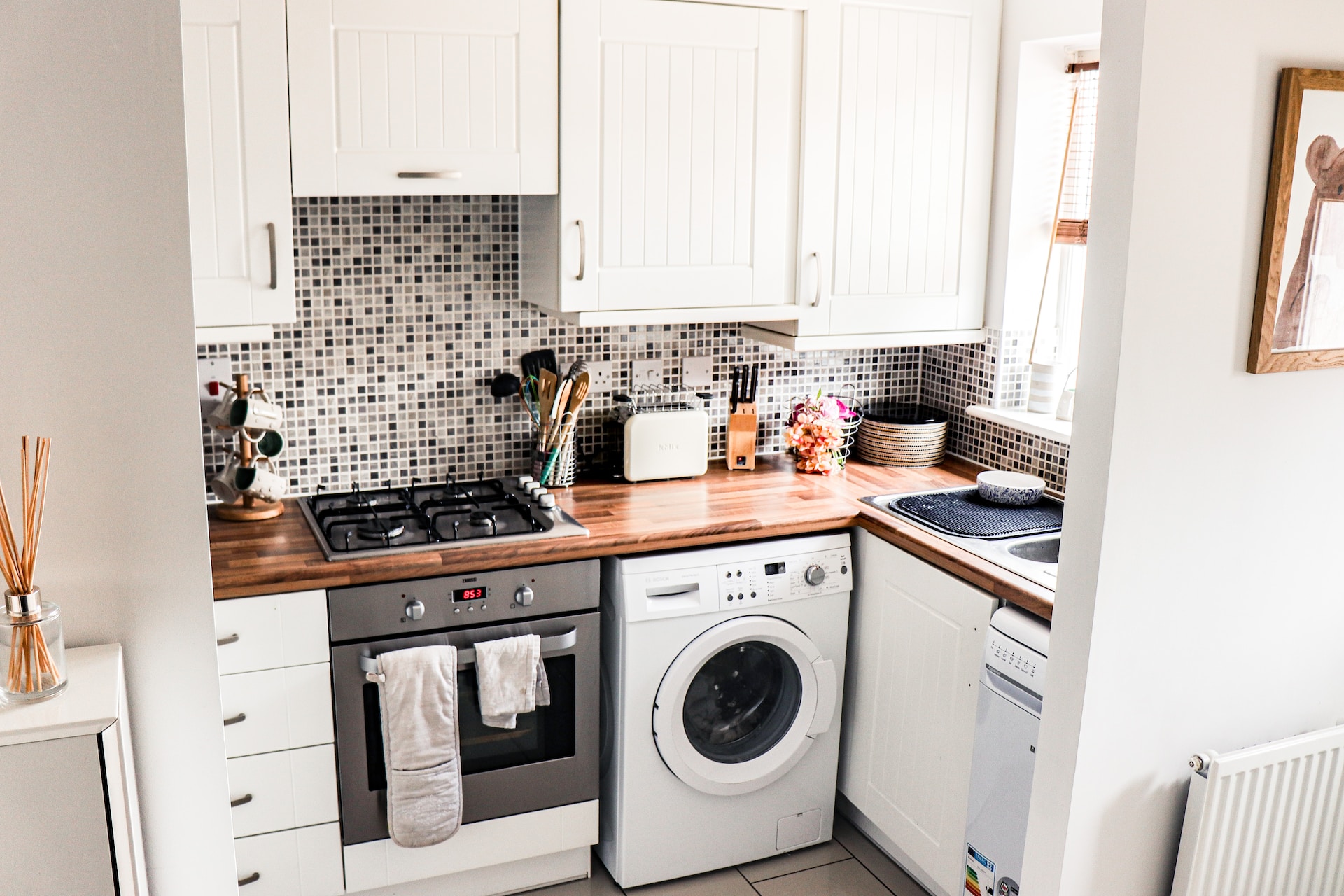If you love to cook and consider yourself a foodie, transforming your home kitchen into a professional-level haven is a great way to enjoy the art of cooking even more. Building an industrial kitchen at home takes time, but it can be easy if you have the right tools and a plan in place.
Before you start your home kitchen remodel, consider getting a home warranty to protect your investment. These warranties can cover the cost of repairing or replacing appliances and major systems that might need attention once you start to use them often. No matter what design you choose or which items you implement, this guide will help you transform your kitchen from a traditional cooking space to an amazing, professional-grade place to make all your favorite recipes.
What is an industrial kitchen?
Technically, an industrial kitchen is a place where food is cooked and given away or sold to the public. However, you can also enjoy the many perks of having this type of kitchen in your own home to make your favorite foods. Having an industrial kitchen at home gives you a lot more space to work, higher-grade appliances, and a larger capacity for cooking and storing food. While a traditional kitchen is made for cooking for families, an industrial kitchen is designed for serious chefs who make much more than nightly dinners. These kitchens typically feature high-end appliances and large sinks and fridges, and they tend to incorporate easy-clean materials like stainless steel rather than butcher block or stone.
Assessing your needs and planning
Before implementing your new industrial kitchen design, it’s critical that you carefully assess your space first. Here are some key things to keep in mind when you’re in the planning stages.
Assessing your space: Determining the feasibility and requirements
Begin by evaluating your available square footage. You may need to knock down a wall to make more room, or you may find that your current kitchen has plenty of existing floor space for the new industrial layout.
1. Analyze your kitchen: Carefully analyze your kitchen’s existing infrastructure and determine whether things like new plumbing and electrical systems are needed for everything to work correctly. If in doubt, hire professionals to help you determine what you’ll need.
2. Investigate the regulations and permits that you need: Always keep local regulations and permit requirements in mind. If you’re doing a major remodel, some jurisdictions require you to have a variety of permits before work can begin. Check with your local city or county to confirm what you’ll need to get beforehand so that everything is done legally.
3. Identify your storage needs. This includes the refrigerator and freezer for food storage as well as pantry space for the storage of dry goods and ingredients. Don’t forget to consider pot and pan storage and storage for tableware.
Defining your goals: Identifying your specific culinary needs and aspirations
Defining your goals is a crucial step in a successful kitchen remodel. Consider your specific culinary needs and aspirations to set clear objectives. Think about the type of cuisine you enjoy and the specific cooking techniques you use, as this will influence the equipment and layout required for your industrial kitchen. Carefully analyze your menu requirements, especially if you plan to start a home-based food business or entertain guests regularly. Identify the appliances, storage, and prep areas needed to execute your desired menu efficiently. Additionally, consider the capacity and volume you anticipate, whether you’ll be cooking for large groups or catering events. This will help you plan for appropriate refrigeration, storage solutions, and appliances that can accommodate your projected needs.
Creating a budget: Estimating costs and prioritizing investments
Taking time to create a budget helps you assess your needs and determine how much your kitchen upgrade will cost. Prioritize essential items based on your menu, cooking style, and how much volume you plan to produce. Always compare prices and look at the costs from several different manufacturers, contractors, and suppliers. It’s vital to look at the potential return on investment for every item you purchase so you’re allocating funds in the best possible way. Finally, remember to leave some room in your budget for any unexpected costs or upgrades you might make in the future.
Designing your industrial kitchen
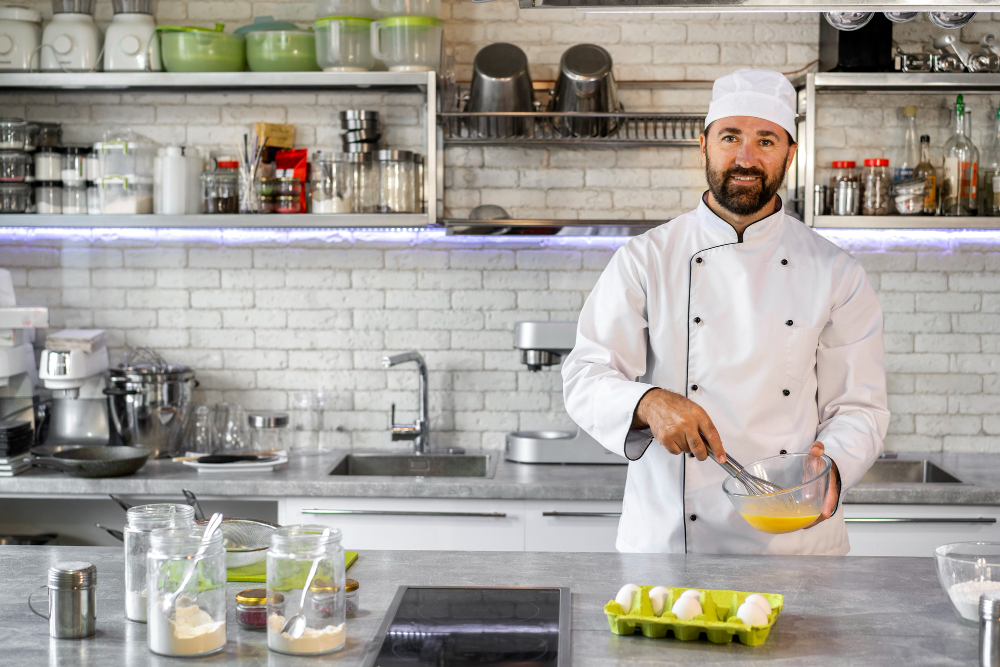
Consider the overall layout
Creating a functional and efficient industrial kitchen begins with carefully considering the layout. Whether you opt for the assembly line, island, zone-style, galley, or open kitchen design, each offers unique advantages in terms of workflow, organization, and aesthetics. Let’s explore the possibilities.
- Assembly line: This layout has a central row or island for food prep, with the final product ready at the end to be served to guests or customers.
- Island: An island layout has a central cooking area with storage, washing stations, and food prep along the perimeter and cooking appliances in the middle.
- Zone-style: This option has separate zones for each type of activity, including baking, frying, or soup and salad prep.
- Galley: For this layout, appliances are laid out along the perimeter of each parallel wall, usually designed for smaller kitchens.
- Open kitchen: This design features an open space with appliances and storage clearly visible from an adjacent room like the dining room or living space.
Planning the workflow
Creating a well-planned workflow is crucial for maximizing productivity and minimizing wasted effort in your industrial kitchen. A key principle is the “kitchen work triangle,” which consists of the paths connecting the primary cooking area, food prep area, and storage space. Positioning these areas strategically ensures seamless transitions between tasks.
When selecting a layout, consider how the placement of appliances, workstations, and storage areas will impact workflow. Carefully analyzing and optimizing these placements will greatly enhance the efficiency of your kitchen operations.
Zoning and organization
Proper zoning and organization are important to help you accomplish each task as efficiently as possible. It also ensures that you’re maximizing your available space in the best possible way.
- Food prep: Designate separate food prep areas and stock each one with the proper tools and cooking equipment for maximum efficiency. These areas should be near the refrigerator so prepared foods can be stored quickly.
- Storage: Make sure you have proper storage, such as an industrial fridge and freezer for cold foods, a pantry area for dry ingredients, and cabinets for pots and pans, utensils, plates, table linens, and cups.
- Cooking: Once the food is prepped, it should go to its individual cooking station based on the type of recipe and requirements. A range-oven combo and a commercial fryer are both great examples.
- Service: The service area is where each plate is prepped and garnished before it heads to your guests or your customers and should be as close to the dining area as possible.
- Cleaning: The cleaning zone is designated for dirty dishes and should be separate from the kitchen. This area typically includes a large three-section sink, a drying rack, and a commercial dishwasher.
- Delivery: Designate a separate delivery area away from the main kitchen where you can receive goods from suppliers, including ingredients, packaging deliveries, and other items you’ll need when you cook commercially.
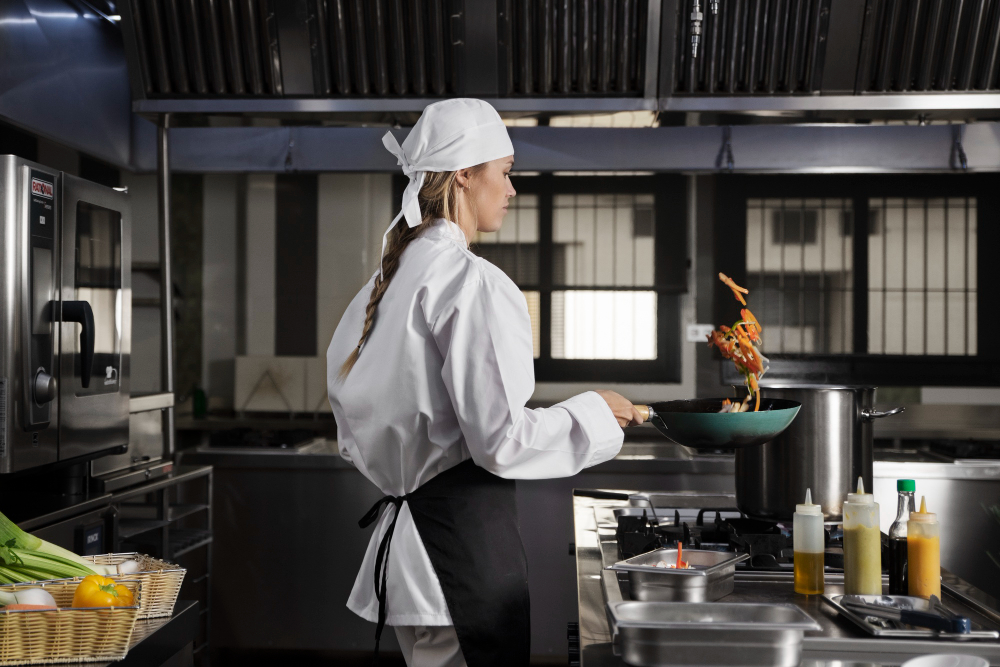
Ergonomics and safety
Proper ergonomic principles should always be a priority when you’re cooking. These principles help to reduce strain and fatigue for yourself and any kitchen staff. Look at things like the counter height, the workstation layout, and appliance and equipment placement to maximize comfort and reduce the risk of injuries. Consistently implement proper safety measures, including plenty of ventilation, a fire suppression system, and adequate lighting to design a safe working environment. Adapt these considerations to fit your kitchen layout and design.
Selecting suitable materials: Durable surfaces for heavy-duty use
Assess durability requirements: Consider things like the type of food prep, the frequency of use, and the potential for wear and tear when choosing materials for flooring, countertops, and walls near cooking stations. Look for materials that can handle high temperatures, stains, moisture, and heavy impacts to ensure longevity and minimal maintenance.
Recommended materials for heavy-duty use: Look for materials like stainless steel, which is highly durable, heat-resistant, and easy to clean. Quartz is also durable and resists scratches and stains, and it comes in a wide variety of styles. Ceramic tile and epoxy flooring are good choices for high-traffic kitchens thanks to their slip-resistance, durability, and easy-to-clean materials. Remember to take things like the cost, aesthetics, and your specific functional requirements into account when shopping for kitchen materials.
Lighting: Enhancing visibility for precision cooking
Proper lighting makes cooking easier and helps you prep food more accurately. Consider installing LED lighting in your kitchen – it lasts longer, costs less to operate, and doesn’t produce heat as traditional lighting does. Install bright overhead lighting and lighting over the sink and stovetop so you can see more clearly when you prep and cook.
Essential appliances for a professional kitchen
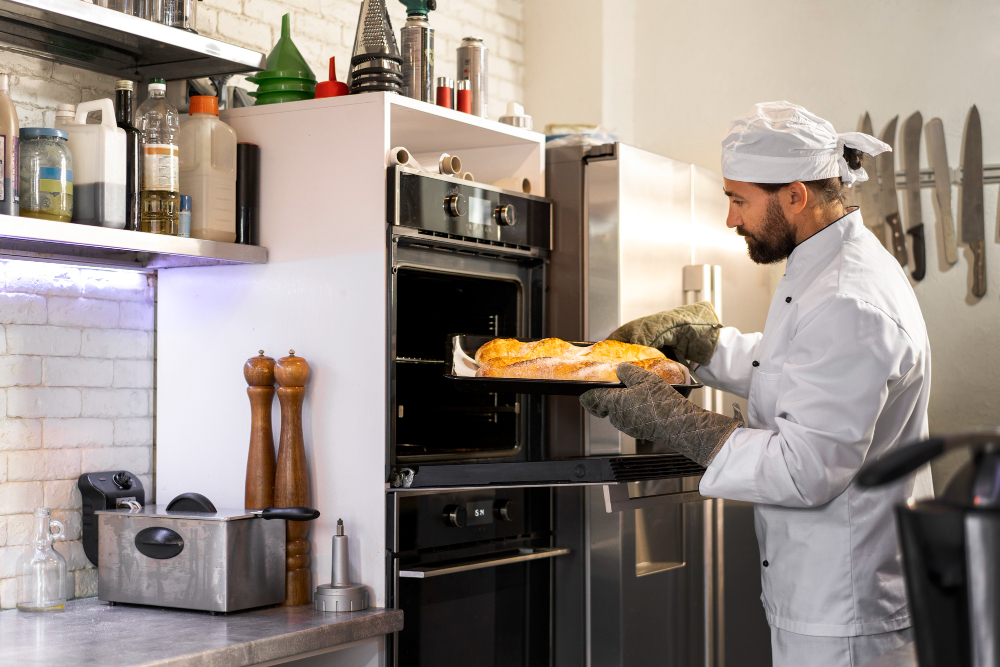
The type of appliances you choose is vital to ensuring that your industrial kitchen operates the way it should. Here are some essential appliances to add to your new professional kitchen:
Industrial-grade stove and oven
These high-powered appliances help you harness precision when cooking. A large oven with multiple burners on the stove lets you cook several dishes at once. Consider a double oven for even more cooking ability – you can also use one of the ovens to keep dishes warm while you prepare the others.
Refrigerator and freezer solutions
The right industrial fridge and freezer help to preserve freshness and extend your food storage capacity. Look for large, roomy fridges and separate, walk-in freezers so you can freeze ingredients until you need them or freeze dishes you’ve already cooked so you can heat them up and enjoy them later.
Ventilation hoods
Install a large ventilation hood over your stove to help eliminate smoke, steam, and odors. This essential appliance helps to keep the air in your kitchen clean and smelling nice, and it’s also a requirement in some states in terms of permitting since it may help to reduce the chances of a fire.
Industrial-grade dishwasher
Washing dirty dishes is cumbersome and time-consuming. Consider installing an industrial-sized and industrial-grade dishwasher to help you simplify the cleaning and maintenance process while also sanitizing your dishes.
Countertop appliances
Add a few must-have tools to increase speed and versatility, like an electric food chopper, a powerful blender, a small toaster oven, a commercial coffee pot, or a small countertop fryer. Choose small appliances that’ll make the food prep portion of your cooking faster and easier.
Additional equipment
You may want to consider other specialized appliances based on your unique culinary needs, including grills and griddles, a convection oven, or sous vide machine. Think about your menu and cooking style to help you determine which pieces of additional equipment would work best for you.
Understanding warranty terms: key factors to consider before purchasing appliances
When purchasing high-end appliances, it’s important to consider the warranty terms to protect your investment. Opting for a home warranty plan that covers repairs or replacements is a wise choice. Evaluate the coverage and duration of the warranty, ensuring it aligns with your needs. Check if the plan includes commercial-grade kitchen appliances and review any limitations or exclusions. Familiarize yourself with the repair and replacement policies, understanding the claim process and what to expect.
Additionally, inquire about additional coverage options offered by the warranty provider, such as extended coverage for specific appliances or components for an extra fee. Being thorough in understanding the warranty terms ensures peace of mind and proper protection for your valuable appliances.
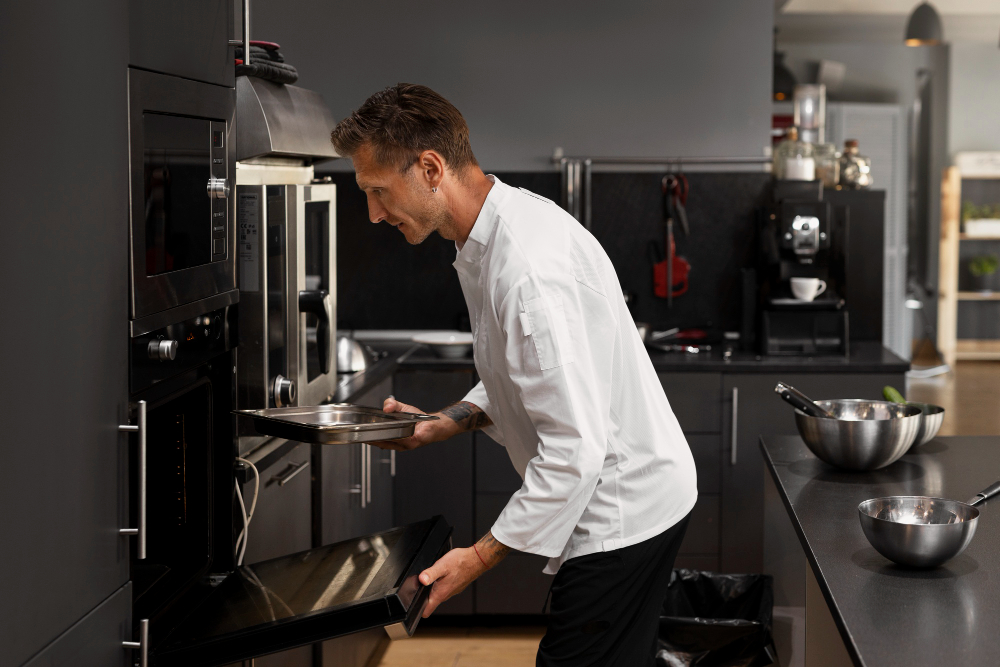
Ensuring protection: Home insurance for your industrial kitchen
As you embark on the exciting journey of transforming your home kitchen into a professional-grade haven, it’s essential to safeguard your investment. Beyond the meticulous planning, budgeting, and goal-setting, one crucial aspect often overlooked is home insurance. Given the significant changes and valuable additions you’re making to your property, obtaining comprehensive home insurance is a prudent step.
Why consider home insurance for your industrial kitchen?
A home insurance policy provides financial protection against unforeseen events that could potentially damage your property or its contents. As you introduce high-end appliances, durable materials, and other valuable additions to create your industrial kitchen, the need for adequate insurance coverage becomes apparent.
Coverage for appliances and equipment:
Home insurance can cover the cost of repairing or replacing appliances and equipment in case of damage due to covered perils. This is particularly important for industrial-grade stoves, ovens, refrigerators, and other specialized tools that contribute to the functionality of your professional kitchen.
Protection against unforeseen events:
While you’re focused on perfecting your culinary skills, unexpected events like fires, floods, or other disasters can pose a threat to your newly designed space. Home insurance provides a safety net, offering financial assistance to repair or replace damaged property and possessions.
Liability coverage:
Liability coverage becomes crucial if you plan to entertain guests or even start a home-based food business. In the event of accidents or injuries on your property, liability coverage can help cover legal expenses and medical bills, offering you peace of mind as you pursue your culinary endeavors.
Choosing the right home insurance:
When selecting a home insurance policy, it’s important to assess the specific needs of your industrial kitchen. Ensure that the policy covers the increased value of your property due to the kitchen remodel and the inclusion of commercial-grade appliances. Pay attention to coverage limits, deductibles, and any exclusions related to business activities conducted from your home.
While the focus is often on your industrial kitchen’s aesthetics, functionality, and efficiency, don’t overlook the importance of securing it with a robust home insurance policy. By incorporating insurance into your overall plan, you can confidently pursue your passion for cooking in a space that’s not only professionally equipped but also safeguarded against the uncertainties of unforeseen events.
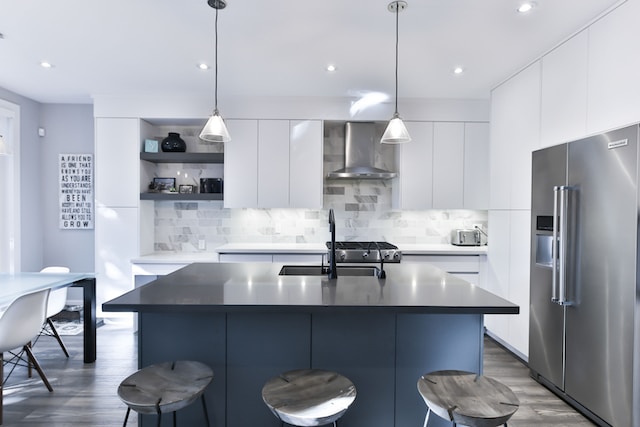
With some careful planning, budgeting, and goal setting, you can transform your current traditional home kitchen into an industrial cooking space. Keep these tips in mind and consider the best layout, the types of appliances you’ll need, and which zones you should set up. Implement a home warranty to protect your investment, and get ready to design an amazing professional-grade kitchen you’ll love to use for years to come.

